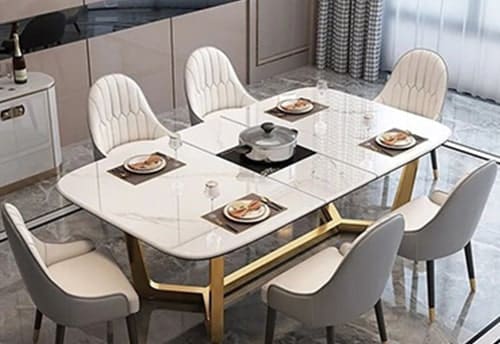Choosing the perfect island table for your kitchen layout involves several key considerations. By focusing on aspects such as size, functionality, design, and materials, you can find an island table that not only complements your kitchen but also enhances its usability and aesthetic appeal.
Assess Your Space
The first step in selecting an island table is to measure your kitchen space. Ensure that the island fits comfortably without overcrowding the area. A general rule of thumb is to maintain at least 36 to 48 inches of space around the island for easy movement and accessibility.
Define the Purpose
Determine the primary function of your island table. Will it be used mainly for food preparation, dining, storage, or a combination of these? If you need additional prep space, consider an island with a large countertop. For dining purposes, ensure there is enough overhang for seating. Islands with built-in storage or shelves can help keep your kitchen organized.
Choose the Right Shape and Size
Island tables come in various shapes and sizes, including rectangular, square, L-shaped, and even circular designs. The shape should complement your kitchen’s layout. For instance, a rectangular island is suitable for larger kitchens, while a square or circular island might fit better in smaller spaces.
Select the Material
The material of your island table should match or complement the rest of your kitchen. Popular choices include granite, marble, quartz, butcher block, and stainless steel. Each material has its own benefits: granite and marble are durable and elegant, quartz is low-maintenance, butcher block offers a warm, rustic feel, and stainless steel is modern and easy to clean.
Consider Additional Features
Modern island tables often come with a range of additional features, such as built-in sinks, cooktops, or electrical outlets. These features can greatly enhance the functionality of your kitchen. Think about how you plan to use the island and choose features that will make your kitchen activities more convenient.
Style and Aesthetics
Your island table should reflect your personal style and blend seamlessly with your kitchen decor. Whether you prefer a contemporary, traditional, farmhouse, or industrial look, there is an island design to match. Pay attention to details like color, finish, and hardware to ensure the island fits your aesthetic vision.
Budget Considerations
Finally, consider your budget. Island tables can range from affordable DIY options to high-end custom designs. Determine how much you are willing to spend and explore options within your price range. Remember that investing in a high-quality island can add significant value to your home.
Conclusion
Choosing the right island table for your kitchen layout involves careful planning and consideration. By assessing your space, defining the table’s purpose, selecting the appropriate shape, size, and material, considering additional features, and staying within your budget, you can find the perfect island table that enhances both the functionality and beauty of your kitchen

